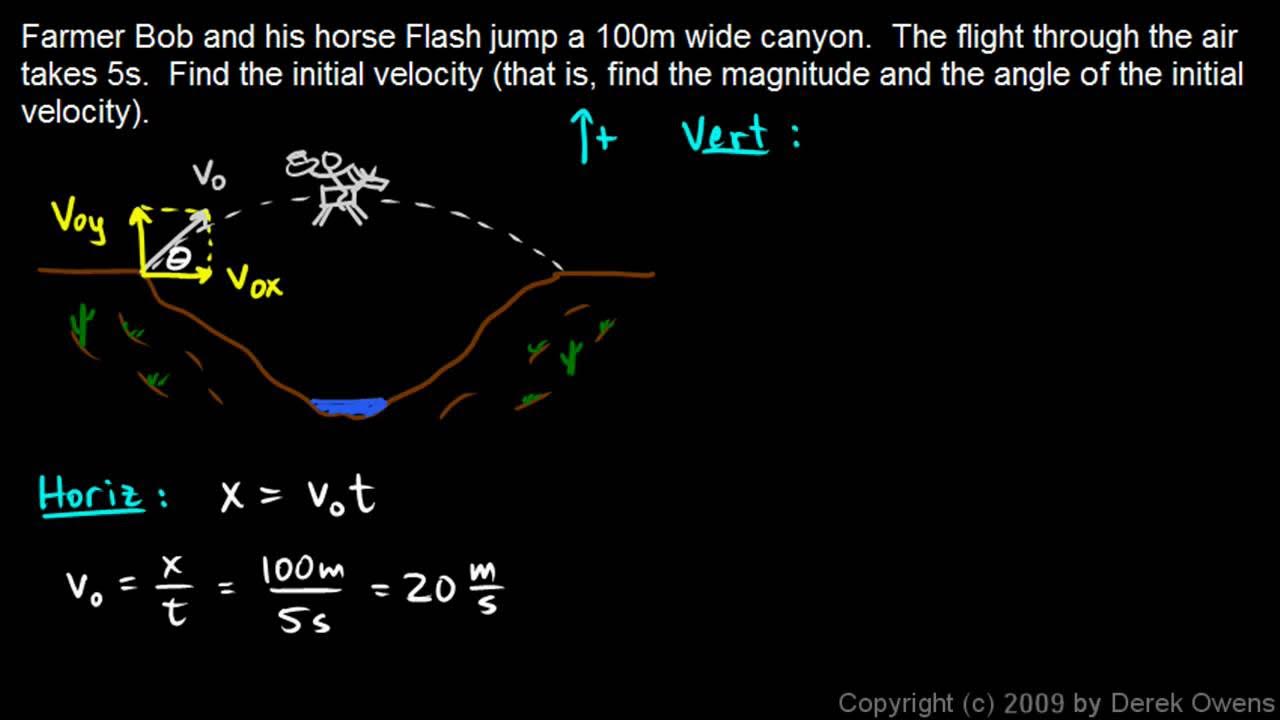AP Physics B Kinematics Presentation #72
TLDRThis script explains the physics of projectile motion, focusing on the horizontal component of velocity at the apex of a ball's trajectory. Starting with a 20 m/s throw at a 60-degree angle, it uses trigonometry to determine that the horizontal velocity remains constant throughout the flight. The cosine of 60 degrees, which equals 1/2, is applied to find that the horizontal velocity (Vx) is 10 m/s at the top of the trajectory, illustrating the principle of no horizontal acceleration in the absence of external forces.
Takeaways
- 🚀 The ball is thrown with an initial velocity of 20 meters per second at a 60-degree angle above the horizontal.
- 📐 A diagram is used to visualize the parabolic trajectory of the ball from its initial position to the apex and back down to the ground.
- 🔍 The horizontal component of the ball's velocity, denoted as VX, is of particular interest at the apex of the trajectory.
- 🌐 It is noted that the horizontal velocity remains constant throughout the motion due to the absence of horizontal acceleration.
- 📉 The vertical component of the velocity changes due to gravity, but the horizontal component does not.
- 📚 The script uses trigonometric principles to calculate the horizontal component of velocity at the top of the trajectory.
- 📈 The cosine of the 60-degree angle is used to find the horizontal component of the initial velocity.
- 🧭 The cosine of 60 degrees is equal to 1/2, which simplifies the calculation of VX.
- 🔢 The calculation results in VX being 20 meters per second times 1/2, giving a value of 10 meters per second for the horizontal velocity at the apex.
- 🔄 The horizontal velocity of 10 meters per second is consistent at the apex and throughout the trajectory.
- 📝 The script provides a clear explanation of how to calculate the horizontal component of velocity at the top of a projectile's path using basic trigonometry.
Q & A
What is the initial velocity of the ball when it is thrown?
-The initial velocity of the ball is 20 meters per second.
At what angle is the ball thrown above the horizontal?
-The ball is thrown at a 60-degree angle above the horizontal.
What is the parabolic motion mentioned in the script?
-The parabolic motion refers to the curved path that a projectile follows when thrown at an angle into the air, influenced by gravity.
What is the significance of the term 'apex' in the context of the script?
-The 'apex' refers to the highest point in the trajectory of the ball, where the vertical component of its velocity is momentarily zero.
Why does the horizontal component of the velocity remain constant throughout the trajectory?
-The horizontal component of the velocity remains constant because there is no horizontal acceleration acting on the ball; only gravity affects the vertical motion.
What is the relationship between the initial velocity and its components in the horizontal and vertical directions?
-The initial velocity can be resolved into horizontal (Vx) and vertical (Vy) components using trigonometric functions based on the angle of projection. In this case, Vx is found using the cosine of the angle.
How is the horizontal component of the velocity (Vx) calculated?
-Vx is calculated using the formula Vx = initial velocity * cos(angle). Here, Vx = 20 m/s * cos(60°).
What is the value of the cosine of 60 degrees?
-The cosine of 60 degrees is 1/2, which simplifies the calculation of Vx to 20 m/s * 1/2.
What is the horizontal component of the velocity at the apex of the trajectory?
-At the apex, the horizontal component of the velocity (Vx) is 10 meters per second, which is the same as at the initial position due to no horizontal acceleration.
How does the script demonstrate the application of trigonometry in physics?
-The script demonstrates the use of trigonometry to resolve the initial velocity into its horizontal and vertical components, and to find the horizontal velocity at the apex using the cosine function.
What would happen to the horizontal component of the velocity if there was air resistance?
-If air resistance were present, it would act against the motion of the ball, gradually reducing the horizontal component of the velocity over time.
Outlines
🚀 Projectile Motion Analysis
This paragraph discusses the physics of a ball thrown at a 60-degree angle with a velocity of 20 meters per second. The focus is on determining the horizontal component of the ball's instantaneous velocity at the apex of its trajectory. The explanation begins with a visual representation of the parabolic motion, emphasizing the constant horizontal velocity due to the lack of horizontal acceleration. The calculation of the horizontal component (Vx) is derived using trigonometric principles, specifically the cosine of 60 degrees, resulting in a horizontal velocity of 10 meters per second at the top of the trajectory.
Mindmap
Keywords
💡Projectile Motion
💡Velocity
💡Angle of Projection
💡Horizontal Component
💡Instantaneous Velocity
💡Apex
💡Parabolic Trajectory
💡SoHCaHTOA
💡Constant Horizontal Velocity
💡Force of Gravity
💡Trigonometric Functions
Highlights
The ball is thrown with an initial velocity of 20 meters per second at a 60-degree angle above the horizontal.
A diagram is drawn to visualize the parabolic trajectory of the ball's motion.
The horizontal component of velocity, VX, remains constant throughout the trajectory due to lack of horizontal acceleration.
At the apex of the trajectory, the horizontal velocity component is of interest.
The initial velocity and angle allow for the calculation of the horizontal velocity component using trigonometry.
The cosine of 60 degrees is used to find the horizontal component of velocity.
The cosine of 60 degrees equals 1/2, simplifying the calculation.
The horizontal velocity component at the apex is calculated to be 10 meters per second.
The horizontal velocity component remains 10 meters per second throughout the entire trajectory.
The problem-solving approach involves understanding projectile motion and applying trigonometric principles.
The importance of recognizing that there is no horizontal acceleration affecting the motion.
The method demonstrates how to break down a projectile motion problem into its components.
The use of sohcahtoa (a mnemonic for trigonometric ratios) to simplify the calculation process.
The explanation clarifies that the horizontal velocity component is the same at the top and at the start of the trajectory.
The demonstration of how to apply the cosine function to find a velocity component in projectile motion.
The final result emphasizes the consistent horizontal velocity of 10 meters per second in the absence of horizontal forces.
Transcripts
5.0 / 5 (0 votes)
Thanks for rating:





